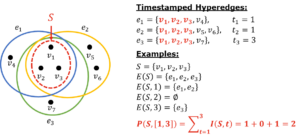Autonomous driving in an urban environment with surrounding agents remains challenging. One of the key challenges is to accurately predict the traversability map that probabilistically represents future trajectories considering multiple contexts: inertial, environmental, and social. To address this, various approaches have been proposed; however, they mainly focus on considering the individual context. In addition, most studies utilize expensive prior information (such as HD maps) of the driving environment, which is not a scalable approach. In this study, we extend a deep inverse reinforcement learning-based approach that can predict the traversability map while incorporating multiple contexts for autonomous driving in a dynamic environment. Instead of using expensive prior information of the driving scene, we propose a novel deep neural network to extract contextual cues from sensing data and effectively incorporate them in the output, i.e., the reward map. Based on the reward map, our method predicts the ego-centric traversability map that represents the probability distribution of the plausible and socially acceptable future trajectories. The proposed method is qualitatively and quantitatively evaluated in real-world traffic scenarios with various baselines. The experimental results show that our method improves the prediction accuracy compared to other baseline methods and can predict future trajectories similar to those followed by a human driver.
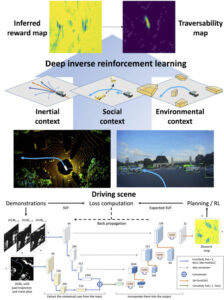
This paper introduces a robot system that is designed to assist postal workers by carrying heavy packages in a complex urban environment such as apartment complex. Since most of such areas do not have access to reliable GPS signal reception, we propose a 3-D point cloud map based matching localization with robust position estimation along with a perception-based visual servoing algorithm. The delivery robot is also designed to communicate with the control center so that the operator can monitor the current and past situation using onboard videos, obstacle information, and emergency stop logs. Also, the postal worker can choose between autonomous driving mode and follow-me mode using his/her mobile device. To validate the performance of the proposed robot system, we collaborated with full-time postal workers performing their actual delivery services for more than four weeks to collect the field operation data. Using this data, we were able to confirm that the proposed map-matching algorithm performs well in various environments where the robot could navigate with reliable position accuracy and obstacle avoidance capability.
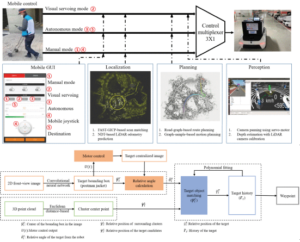
Driving at an unsignalized intersection is a complex traffic scenario that requires both traffic safety and efficiency. At the unsignalized intersection, the driving policy does not simply maintain a safe distance for all vehicles. Instead, it pays more attention to vehicles that potentially have conflicts with the ego vehicle, while guessing the intentions of other vehicles. In this paper, we propose an attention-based driving policy for handling unprotected intersections using deep reinforcement learning. By leveraging attention, our policy learns to focus on more spatially and temporally important features within its egocentric observation. This selective attention enables our policy to make safe and efficient driving decisions in various congested intersection environments. Our experiments show that the proposed policy not only outperforms other baseline policies in various intersection scenarios and traffic density conditions but also has interpretability in its decision process. Furthermore, we verify our policy model’s feasibility in real-world deployment by transferring the trained model to a full-scale vehicle system. Our model successfully performs various intersection scenarios, even with noisy sensory data and delayed responses. Our approach reveals more opportunities for implementing generic and interpretable policy models in realworld autonomous driving.
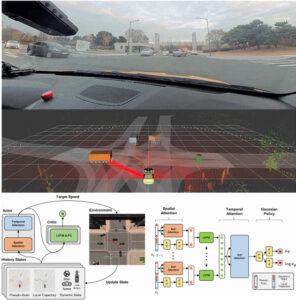
Geon Lee, Minyoung Choe and Kijung Shin
IJCAI 2022: International Joint Conference on Artificial Intelligence 2022
Abstract: Sequences of group interactions, such as emails, online discussions, and co-authorships, are ubiquitous; and they are naturally represented as a stream of hyperedges. Despite their broad potential applications, anomaly detection in hypergraphs (i.e., sets of hyperedges) has received surprisingly little attention, compared to that in graphs. While it is tempting to reduce hypergraphs to graphs and apply existing graph-based methods, according to our experiments, taking higher-order structures of hypergraphs into consideration is worthwhile. We propose HashNWalk, an incremental algorithm that detects anomalies in a stream of hyperedges. It maintains and updates a constant-size summary of the structural and temporal information about the stream. Using the summary, which is the form of a proximity matrix, HashNWalk measures the anomalousness of each new hyperedge as it appears. HashNWalk is (a) Fast: it processes each hyperedge in near real-time and billions of hyperedges within a few hours, (b) Space Efficient: the size of the maintained summary is a predefined constant, (c) Effective: it successfully detects anomalous hyperedges in real-world hypergraphs.

Hyunjin Hwang*, Seungwoo Lee*, Chanyoung Park, and Kijung Shin
SIGIR 2022: International ACM SIGIR Conference on Research and Development in Information Retrieval 2022
Abstract: Hypergraphs (i.e., sets of hyperedges) naturally represent group relations (e.g., researchers co-authoring a paper and ingredients used together in a recipe), each of which corresponds to a hyperedge (i.e., a subset of nodes). Predicting future or missing hyperedges bears significant implications for many applications (e.g., collaboration and recipe recommendation). What makes hyperedge prediction particularly challenging is the vast number of non-hyperedge subsets, which grows exponentially with the number of nodes. Since it is prohibitive to use all of them as negative examples for model training, it is inevitable to sample a very small portion of them, and to this end, heuristic sampling schemes have been employed. However, trained models suffer from poor generalization capability for examples of different natures. In this paper, we propose AHP, an adversarial training-based hyperedge-prediction method. It learns to sample negative examples without relying on any heuristic schemes. Using six real hypergraphs, we show that AHP generalizes better to negative examples of various natures. It yields up to 28.2% higher AUROC than the best existing methods and often even outperforms its variants with sampling schemes tailored to test sets.
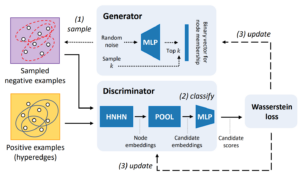
Shinhwan Kang, Kyuhan Lee, and Kijung Shin
PAKDD 2022: Pacific-Asia Conference on Knowledge Discovery and Data Mining 2022
Abstract: Which one is better between two representative graph summarization models with and without edge weights? From web graphs to online social networks, large graphs are everywhere. Graph summarization, which is an effective graph compression technique, aims to find a compact summary graph that accurately represents a given large graph. Two versions of the problem, where one allows edge weights in summary graphs and the other does not, have been studied in parallel without direct comparison between their underlying representation models. In this work, we conduct a systematic comparison by extending three search algorithms to both models and evaluating their outputs on eight datasets in five aspects: (a) reconstruction error, (b) error in node importance, (c) error in node proximity, (d) the size of reconstructed graphs, and (e) compression ratios. Surprisingly, using unweighted summary graphs leads to outputs significantly better in all the aspects than using weighted ones, and this finding is supported theoretically. Notably, we show that a state-of-the-art algorithm can be improved substantially (specifically, 8.2X, 7.8X, and 5.9X in terms of (a), (b), and (c), respectively, when (e) is fixed) based on the observation.
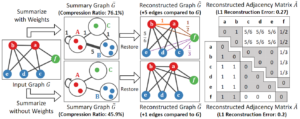
Shinhwan Kang, Kyuhan Lee, and Kijung Shin
ICDE 2022: IEEE International Conference on Data Engineering 2022
Abstract: Are users of an online social network interested equally in all connections in the network? If not, how can we obtain a summary of the network personalized to specific users? Can we use the summary for approximate query answering? As massive graphs (e.g., online social networks, hyperlink networks, and road networks) have become pervasive, graph compression has gained importance for the efficient processing of such graphs with limited resources. Graph summarization is an extensively-studied lossy compression method. It provides a summary graph where nodes with similar connectivity are merged into supernodes, and a variety of graph queries can be answered approximately from the summary graph. In this work, we introduce a new problem, namely personalized graph summarization, where the objective is to obtain a summary graph where more emphasis is put on connections closer to a given set of target nodes. Then, we propose PeGaSus, a linear-time algorithm for the problem. Through experiments on six real-world graphs, we demonstrate that PeGaSus is (a) Effective: node-similarity queries for target nodes can be answered significantly more accurately from personalized summary graphs than from non-personalized ones of similar size, (b) Scalable: it summarizes graphs with up to one billion edges, and (c) Applicable to distributed multi-query answering: it successfully replaces graph partitioning for communication-free multi-query processing.
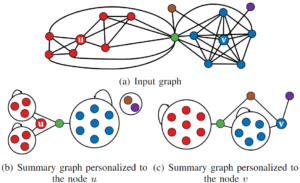
Kyuhan Lee*, Jihoon Ko*, and Kijung Shin
ICDE 2022: IEEE International Conference on Data Engineering 2022
Abstract: Given a massive graph, how can we exploit its hierarchical structure for concisely but exactly summarizing the graph? By exploiting the structure, can we achieve better compression rates than state-of-the-art graph summarization methods?
The explosive proliferation of the Web has accelerated the emergence of large graphs, such as online social networks and hyperlink networks. Consequently, graph compression has become increasingly important to process such large graphs without expensive I/O over the network or to disk. Among a number of approaches, graph summarization, which in essence combines similar nodes into a supernode and describe their connectivity concisely, protrudes with several advantages. However, we note that it fails to exploit pervasive hierarchical structures of real-world graphs as its underlying representation model enforces supernodes to be disjoint.
In this work, we propose the hierarchical graph summarization model, which is an expressive graph representation model that includes the previous one proposed by Navlakha et al. as a special case. The new model represents an unweighted graph using positive and negative edges between hierarchical supernodes, each of which can contain others. Then, we propose Slugger, a scalable heuristic for concisely and exactly representing a given graph under our new model. Slugger greedily merges nodes into supernodes while maintaining and exploiting their hierarchy, which is later pruned. Slugger significantly accelerates this process by sampling, approximation, and memoization. Our experiments on 16 real-world graphs show that Slugger is (a) Effective: yielding up to 29.6% more concise summary than state-of-the-art lossless summarization methods, (b) Fast: summarizing a graph with 0.8 billion edges in a few hours, and (c) Scalable: scaling linearly with the number of edges in the input graph.

Minyoung Choe, Jaemin Yoo, Geon Lee, Woonsung Baek, U Kang, and Kijung Shin
WWW 2022: The Web Conference 2022
Abstract: Graphs are widely used for representing pairwise interactions in complex systems. Since such real-world graphs are large and often evergrowing, sampling a small representative subgraph is indispensable for various purposes: simulation, visualization, stream processing, representation learning, crawling, to name a few. However, many complex systems consist of group interactions (e.g., collaborations of researchers and discussions on online Q&A platforms), and thus they can be represented more naturally and accurately by hypergraphs (i.e., sets of sets) than by ordinary graphs.
Motivated by the prevalence of large-scale hypergraphs, we study the problem of representative sampling from real-world hypergraphs, aiming to answer (Q1) what a representative sub-hypergraph is and (Q2) how we can find a representative one rapidly without an extensive search. Regarding Q1, we propose to measure the goodness of a sub-hypergraph by comparing it with the entire hypergraph in terms of ten graph-level, hyperedge-level, and node-level statistics. Regarding Q2, we first analyze the characteristics of six intuitive approaches in 11 real-world hypergraphs. Then, based on the analysis, we propose MiDaS, which draws hyperedges with a bias towards those with high-degree nodes. Through extensive experiments, we demonstrate that MiDaS is (a) Representative: finding overall the most representative samples among 13 considered approaches, (b) Fast: several orders of magnitude faster than the strongest competitors, which performs an extensive search, and (c) Automatic: rapidly searching a proper degree of bias.

Hyunjin Choo and Kijung Shin
SDM 2022: SIAM International Conference on Data Mining 2022
Abstract: A hypergraph, which generalizes an ordinary graph, naturally represents group interactions as hyperedges (i.e., arbitrary-sized subsets of nodes). Such group interactions are ubiquitous: the sender and receivers of an email, the co-authors of a publication, and the items co-purchased by a customer, to name a few. A higher-order interaction (HOI) in a hypergraph is defined as the co-appearance of a set of nodes in any hyperedge. Our focus is the persistence of HOIs repeated over time, which is naturally interpreted as the strength of group relationships, aiming at answering three questions: (a) How do HOIs in real-world hypergraphs persist over time? (b) What are the key factors governing the persistence? (c) How accurately can we predict the persistence? In order to answer these questions, we investigate the persistence of HOIs in 13 real-world hypergraphs. First, we define how to measure the persistence of HOIs. Then, we examine global patterns and anomalies in the persistence, revealing a power-law relationship. After that, we study the relations between the persistence and 16 structural features of HOIs, some of which are closely related to the persistence. Lastly, based on the 16 structural features, we assess the predictability of the persistence under various settings and find strong predictors. Note that predicting the persistence of HOIs has many potential applications, such as recommending items to be purchased together and predicting missing recipients of emails.
